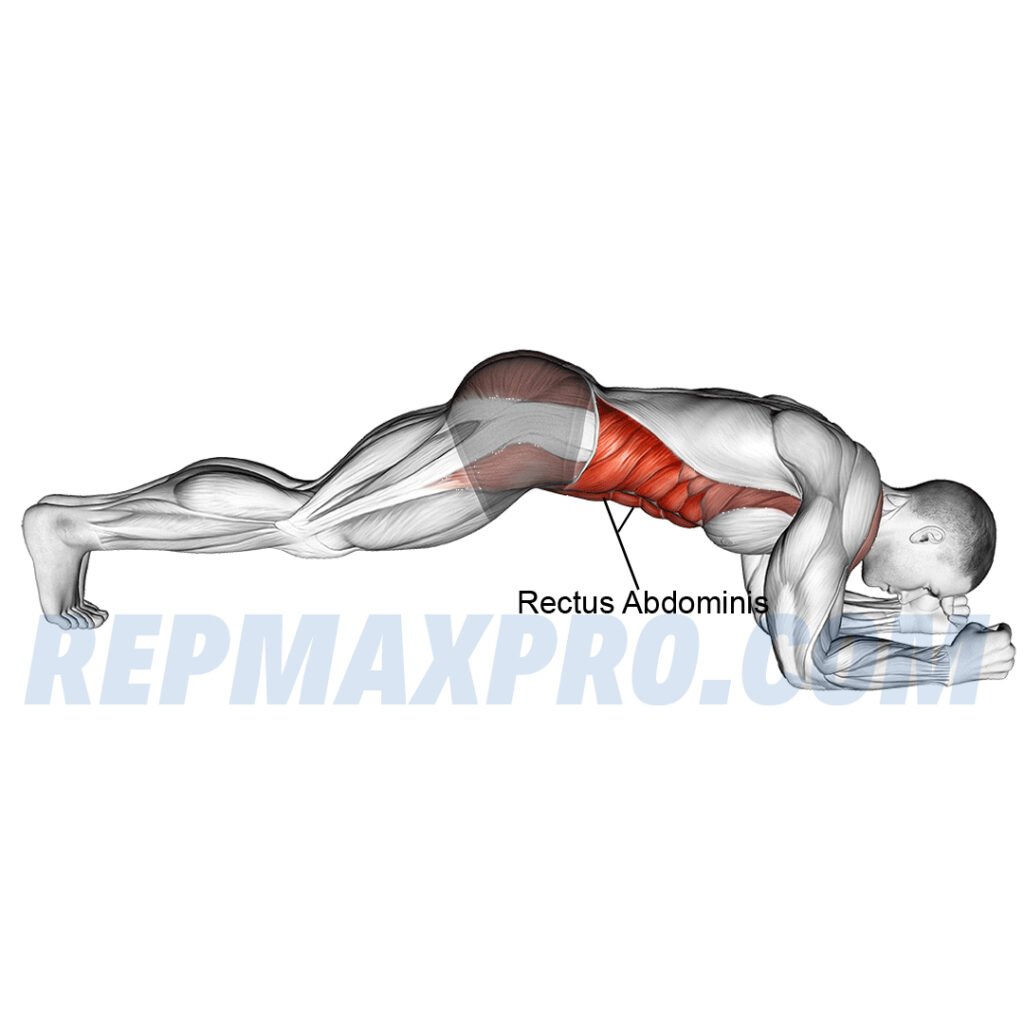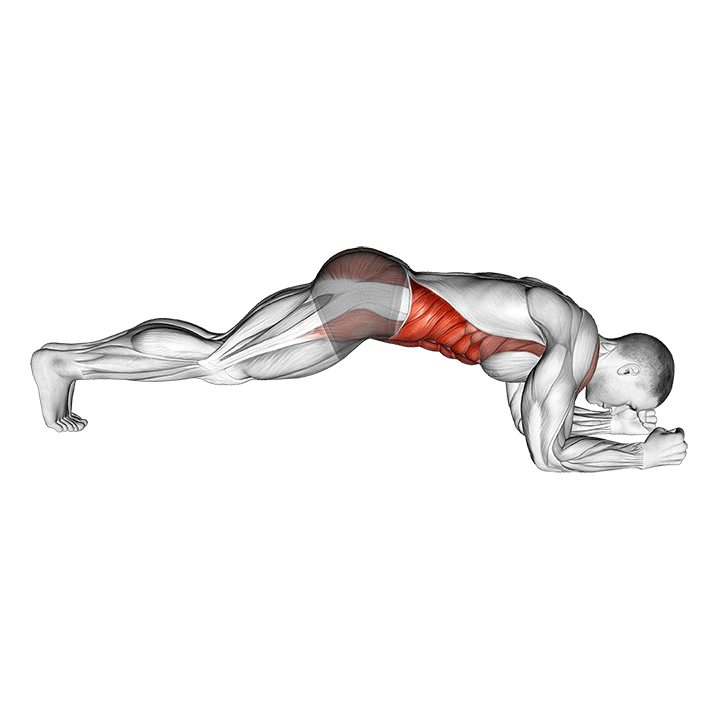Plank
The plank is a fundamental bodyweight exercise that effectively strengthens the core while providing numerous benefits for overall fitness. This isometric exercise requires no equipment, making it accessible to everyone from beginners to advanced athletes.
This is a core-strengthening exercise that involves holding a static position, resembling a plank of wood, for a set amount of time. It focuses on maintaining a neutral spine and engages multiple muscle groups simultaneously. The plank is renowned for its ability to enhance core stability, improve posture, and increase overall body strength.
Targeted Muscle Groups

Primary Muscles:
- Rectus Abdominis: Often referred to as the “six-pack” muscles, these are the primary muscles engaged during the plank to maintain core stability.
- Transversus Abdominis: This deep abdominal muscle supports the spine and helps stabilize the core.
- Obliques (Internal and External): Located on the sides of the abdomen, the obliques assist in maintaining balance and stability.
Secondary Muscles:
- Erector Spinae: These muscles, located along the spine, play a crucial role in keeping your back neutral and stable while performing a plank.
- Deltoids: The shoulder muscles engage to keep the body in a stable position.
- Glutes: The buttocks muscles contribute to overall body stability by helping to keep the pelvis aligned.
- Quadriceps: The front thigh muscles work to stabilize the legs and support the core.
Equipment Needed
- None Required: The plank exercise is a bodyweight movement that requires no equipment. However, using an exercise mat can provide additional comfort and support for your elbows and feet.
How to Perform the Plank: Step-by-Step Guide
Step 1: Start Position
- Begin on Your Hands and Knees: Place your hands directly under your shoulders and your knees under your hips.
- Extend Your Legs: Step your feet back, one at a time, until your body is in a straight line from head to heels. Your toes should be tucked under, and your legs should be fully extended.

Front Plank
Illustration credit © Aliaksandr Makatserchyk
Step 2: Engage Your Core
- Tighten Your Abs: Engage your core by drawing your belly button inward toward your spine.
- Flatten Your Back: Ensure your back is flat and your body is in a straight line. Avoid lifting your hips too high or letting them drop too low.
Step 3: Hold the Position
- Maintain Alignment: Keep your head in a neutral position by looking at the floor. Keep your neck in line with your spine for proper alignment.
- Breathe Normally: Continue to breathe deeply and steadily throughout the exercise. Avoid holding your breath.
Step 4: Finish the Exercise
- Slowly Release: After holding the plank for the desired amount of time, slowly lower your knees to the floor and rest in a child’s pose position to recover.
Recommended Reps and Sets
- Beginners: Hold the plank for 15-30 seconds. Perform 2-3 sets with 30-60 seconds of rest between sets.
- Intermediate: Aim for 30-60 seconds per hold. Complete 3-4 sets with 30-60 seconds of rest in between.
- Advanced: Hold the plank for 60-90 seconds or longer. Perform 4-5 sets with 30-60 seconds of rest between sets.
Pro Tips for Success
- Focus on Form: Proper form is crucial for maximizing the effectiveness of the plank and preventing injury. Make sure your body stays in a straight line, extending from your head to your heels.
- Engage Your Core: Actively engage your abdominal muscles to stabilize your spine and avoid lower back sagging.
- Breathe Regularly: Maintain a steady breathing pattern to sustain the exercise and prevent muscle fatigue.
- Use an Exercise Mat: For added comfort, use a mat to cushion your elbows and feet, especially during longer holds.
- Progress Gradually: Increase the duration and intensity of your planks gradually to build strength and endurance without overstraining.
Common Mistakes to Avoid
- Sagging Hips: Allowing your hips to drop can strain your lower back and reduce the effectiveness of the exercise. Maintain a straight and aligned posture throughout your body.
- Elevating Hips: Lifting your hips too high can shift the focus away from your core and reduce the challenge of the exercise.
- Holding Your Breath: Not breathing regularly can lead to fatigue and reduce exercise performance. Ensure a steady breath throughout the hold.
- Incorrect Hand Placement: Hands should be directly under the shoulders. Incorrect placement can lead to shoulder strain and imbalance.
- Arching Your Back: Steer clear of over-arching your back. Maintain a neutral spine to protect your lower back and engage your core effectively.
The plank is an essential core-strengthening exercise that offers numerous benefits for overall fitness and stability. By engaging multiple muscle groups and requiring no equipment, it is accessible for individuals of all fitness levels. Emphasizing proper form, gradual progression, and avoiding common mistakes can help you maximize the effectiveness of your plank workout. Incorporating planks into your routine can enhance core strength, improve posture, and contribute to a well-rounded fitness regimen.
